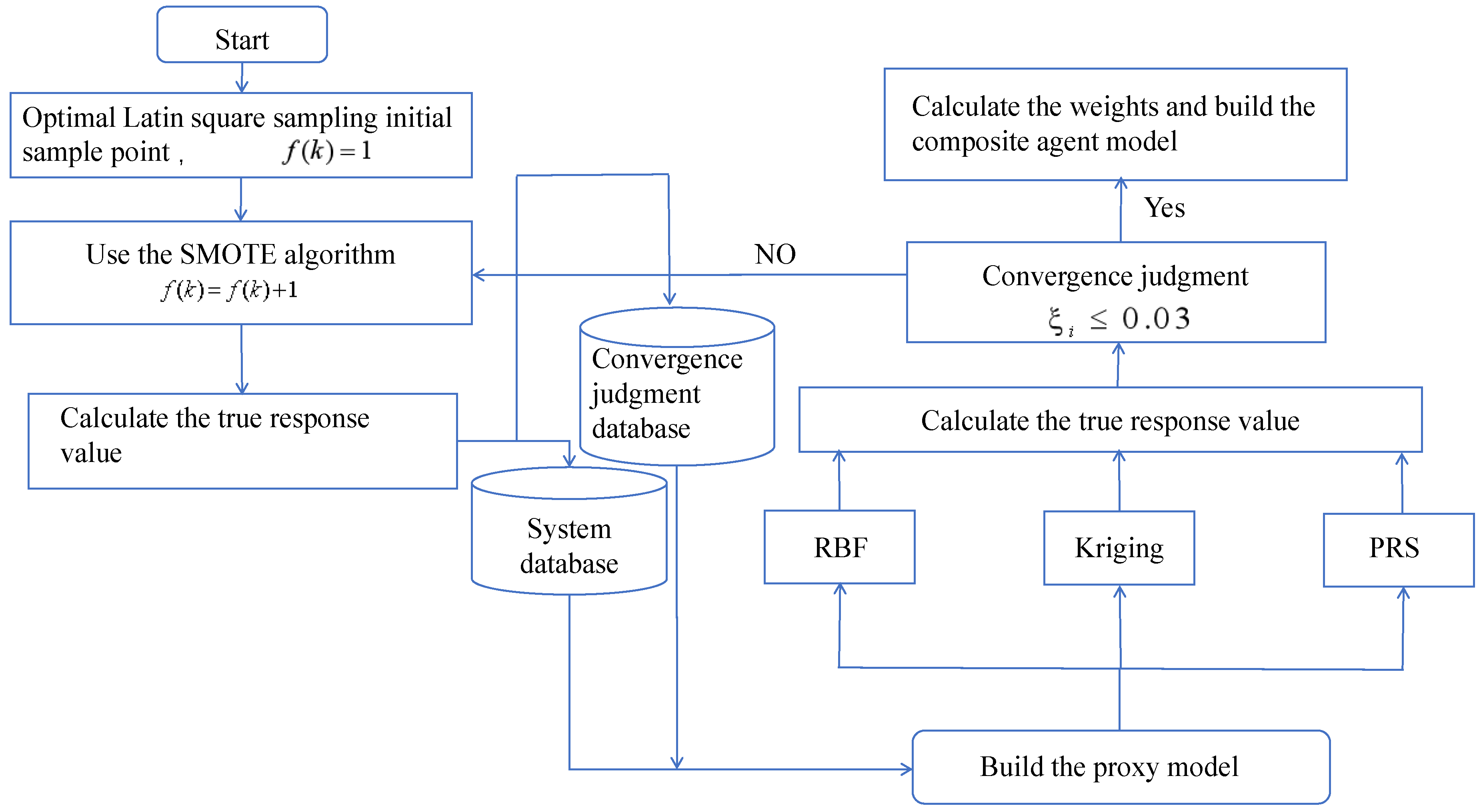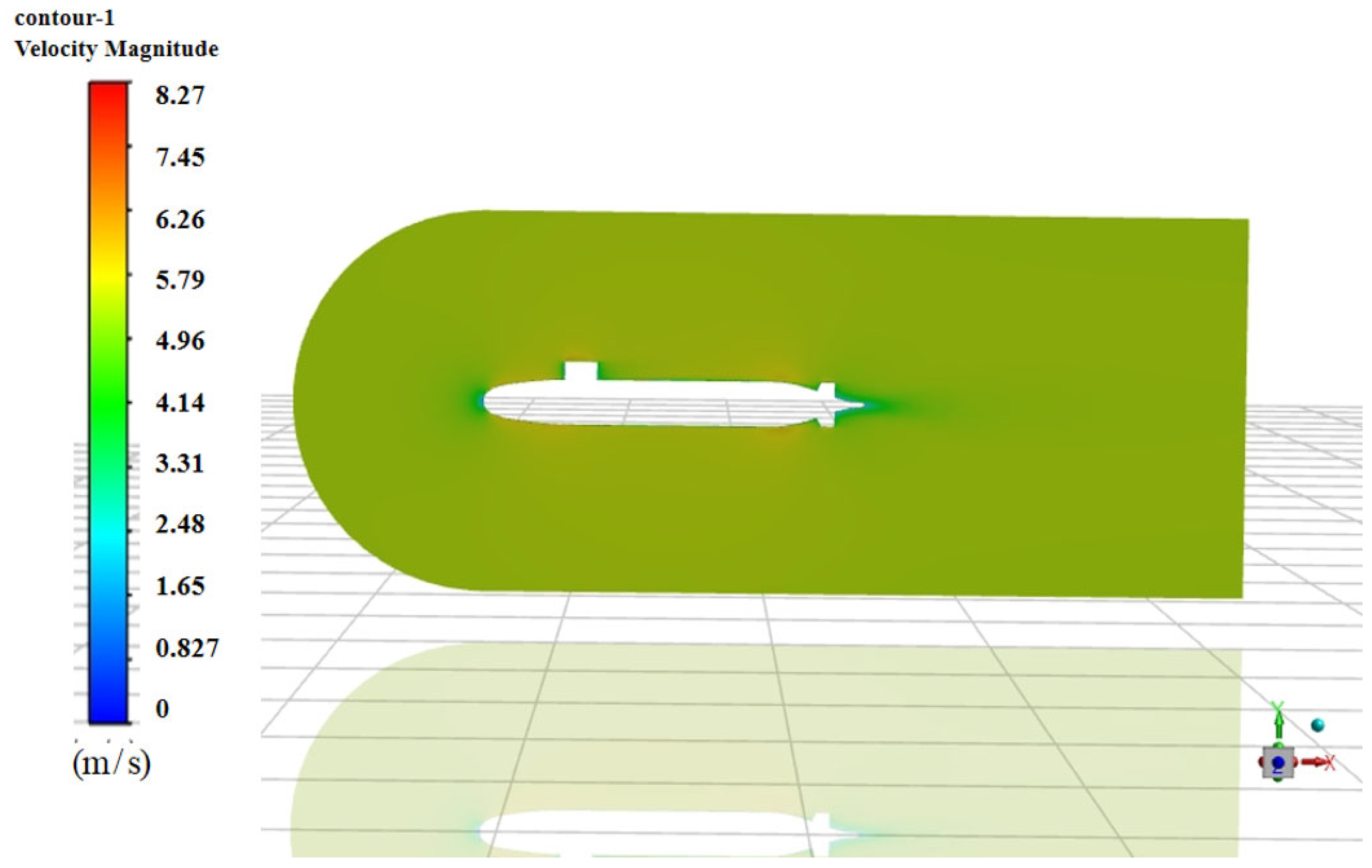Multidisciplinary Design Optimization of Underwater Vehicles Based on a Combined Proxy Model
Abstract
1. Introduction
2. Multi-Objective Optimization Strategy
2.1. Analytic Hierarchy Process
2.2. Collaborative Optimization Framework
3. Combined Proxy Model
3.1. The Process of Building a Proxy Model
- (1)
- Utilize design of experiments (DOEs) sampling to create a real analysis model, store the resulting real response values in the database, and implement a counting function .
- (2)
- When , call the SMOTE algorithm to interpolate the sample points in the database and obtain important sample points. Utilize orthogonal testing to determine the actual response value of these important sample points and store this information in the database.
- (3)
- The sample points of the database were respectively constructed with the RBF, Kriging, and PRS proxy models. The NSGA-II genetic algorithm and collaborative optimization framework are used to optimize the three proxy models, and the optimization conditions were minimized for the main subject set .
- (4)
- To build the convergence judgment sample set, take a sample size of [10%, 20%] from the current database. Utilize the SMOTE algorithm to interpolate the dataset and acquire the actual response value through orthogonal testing. Subsequently, incorporate the constructed convergence judgment sample set into the system set for convergence judgment. The judgment conditions are as follows:where is the true response value after constructing a proxy model for the entire sample set and performing optimization; is the true response value after optimizing the proxy model constructed by the system sample set.
- (5)
- Make a convergence judgment on the three proxy models individually. When the model converges, perform step (6); otherwise, return to step (2) after removing the convergence judgment sample set.
- (6)
- The training sample set is generated by DOEs. The predicted values are obtained using three proxy models. The training sample prediction set is saved, and the root mean square error is calculated for both the training sample set and the training sample prediction set. The root mean square error set is then retained.
- (7)
- The root mean square error set and weight formula (PRESS) are used to determine the weights of the three proxy models, which are then combined to create the combined proxy model.
3.2. SMOTE Algorithm
3.3. Weight Calculation
4. The Theoretical Foundation of Integrated Multidisciplinary Optimization Platforms
4.1. Multidisciplinary Optimization Algorithm
4.2. Introduction to Proxy Models
4.2.1. Radial Basis Function (RBF) Model
4.2.2. Kriging Model
4.2.3. Polynomial Response Surface (PRS) Model
5. Optimization Based on a Combined Proxy Model
5.1. Resistance Analysis
5.2. Energy Consumption Analysis
5.3. Orthogonal Experimental Design
5.4. Multidisciplinary Optimization Framework
5.5. Proxy Model Convergence Condition
5.6. Optimization Results
6. Conclusions
- (1)
- After comparing the combined proxy model built based on the SMOTE algorithm and weight allocation method with other dynamic agent models, it can be seen that it demonstrates good fitting accuracy, optimization efficiency, and generalization performance.
- (2)
- The optimization strategy based on a collaborative optimization framework and the NSGA-II genetic algorithm is applied to the underwater vehicle SUBOFF, demonstrating high efficiency and convergence in optimization.
- (3)
- The optimization strategy is applied to the underwater vehicle SUBOFF. According to the optimization results, the fast performance and energy-saving capabilities of the underwater vehicle SUBOFF have also been enhanced.
Author Contributions
Funding
Institutional Review Board Statement
Informed Consent Statement
Data Availability Statement
Conflicts of Interest
References
- Long, T.; Guo, X.; Peng, L.; Liu, L. Optimization strategy using dynamic radial basis function metamodel based on trust region. J. Mech. Eng. 2014, 50, 184–190. (In Chinese) [Google Scholar] [CrossRef]
- Long, T.; Li, X.; Huang, B.; Jiang, M. Aerodynamic and stealthy performance optimization of airfoil based on adaptive surrogate model. J. Mech. Eng. 2016, 52, 101–111. (In Chinese) [Google Scholar] [CrossRef]
- Diez Silvia, M.; Andrea, V.; Stern, F. Simulation-based design optimization by sequential multi-criterion adaptive sampling and dynamic radial basis functions. In Proceedings of the 11th International Conference on Evolutionary and Deterministic Methods for Design, Optimization and Control with Applications to Industrial and Societal Problems, Glasgow, UK, 14–16 September 2015; pp. 213–228. [Google Scholar]
- Su, G.; Peng, L.; Hu, L. A Gaussian process-based dynamic surrogate model for complex engineering structural reliability analysis. Struct. Saf. 2017, 68, 97–109. [Google Scholar] [CrossRef]
- Luo, W.; Guo, X.; Dai, J.; Rao, T. Hull optimization of an underwater vehicle based on dynamic proxy model. Ocean. Eng. 2021, 230, 109050. [Google Scholar] [CrossRef]
- Pan, W.; Luo, W. Lines optimisation of an underwater vehicle using SMOTE and adaptive minimise LCB based dynamic proxy models. Ships Offshore Struct. 2024, 19, 91–108. [Google Scholar] [CrossRef]
- Goel, T.; Haftka, R.T.; Shyy, W.; Queipo, N.V. Ensemble of surrogates. Struct. Multidiscip. Optim. 2007, 33, 199–216. [Google Scholar] [CrossRef]
- Lee, Y.; Choi, D.H. Pointwise ensemble of meta-models using v nearest points cross-validation. Struct. Multidiscip. Optim. 2014, 50, 383–394. [Google Scholar] [CrossRef]
- Chen, H.; Li, W.; Cui, W.; Liu, Q. A pointwise ensemble of surrogates with adaptive function and heuristic formulation. Struct. Multidiscip. Optim. 2022, 65, 113. [Google Scholar] [CrossRef]
- Yang, X.; Guo, T.; Yu, M.; Chen, M. Optimization of engineering parameters of deflagration fracturing in shale reservoirs based on hybrid proxy model. Geoenergy Sci. Eng. 2023, 231, 212318. [Google Scholar] [CrossRef]
- Zhang, D.; Song, B.; Wang, P.; Chen, X. Multidisciplinary optimization design of a new underwater vehicle with highly efficient gradient calculation. Struct. Multidiscip. Optim. 2017, 55, 1483–1502. [Google Scholar] [CrossRef]
- Mohsen, B.; Mehdi, M.; Mehdi, S. A new approach in system and tactic design optimization of an autonomous underwater vehicle by using Multidisciplinary Design Optimization. Ocean. Eng. 2018, 147, 517–530. [Google Scholar]
- Chen, X.; Wang, P.; Zhang, D. Surrogate-based Multidisciplinary Design Optimization of an Autonomous Underwater Vehicle Hull. In Proceedings of the 2017 16th International Symposium on Distributed Computing and Applications to Business, Engineering and Science(DCABES 2017), Anyang, China, 13–16 October 2017. [Google Scholar]
- Lyu, W.; Luo, W. Design of underwater robot lines based on a hybrid automatic optimization strategy. J. Mar. Sci. Appl. 2014, 13, 274–280. [Google Scholar] [CrossRef]
- Liu, X.; Yuan, Q.; Zhao, M.; Cui, W.; Ge, T. Multiple objective multidisciplinary design optimization of heavier-than-water underwater vehicle using CFD and approximation model. J. Mar. Sci. Technol. 2017, 22, 135–148. [Google Scholar] [CrossRef]
- Adelman, H.M.; Mantay, W.R. Integrated multidisciplinary design optimization of rotorcraft. J. Aircr. 1991, 28, 22–28. [Google Scholar] [CrossRef]
- Kroo, I.; Altus, S.; Braun, R.; Gage, P.; Sobieski, I. Multidisciplinary Optimization Methods for Aircraft Preliminary Design. In Proceedings of the 5th Symposium on Multidisciplinary Analysis and Optimization, Panama City Beach, FL, USA, 7–9 September 1994; pp. 697–707. [Google Scholar]
- Sobieszczanski-Sobieski, J.; Agte, J.S.; Sandusky, R.R. Bilevel integrated system synthesis. AIAA J. 2000, 38, 164–172. [Google Scholar] [CrossRef]
- Nitesh, V.C.; Kevin, W.B.; Lawrence, O.H. SMOTE: Synthetic Minority Over-sampling Technique. J. Artif. Intell. Res. 2002, 16, 321–357. [Google Scholar]
- Pak, C.; Wang, T.T.; Su, X.H. An empirical study on software defect prediction using over-sampling by SMOTE. Int. J. Softw. Eng. Knowl. Eng. 2018, 28, 811–830. [Google Scholar] [CrossRef]
- Deb, K.; Pratap, A.; Agarwal, S.; Meyarivan, T.A.M.T. A fast and elitist multiobjective genetic algorithm: NSGA-II. IEEE Trans. Evol. Comput. 2002, 6, 182–197. [Google Scholar] [CrossRef]
- Kodiyalam, S. Evaluation of Methods for Multidisciplinary Design Optimization (MDO), Phase I; National Aeronautics and Space Administration, Langley Research Center: Hampton, VA, USA, 1998. [Google Scholar]














| V (kt) | CFD (N) | Experiment (N) | Error |
|---|---|---|---|
| 5.93 | 104 | 102.3 | 1.66% |
| 10 | 279.8 | 283.8 | 1.41% |
| 11.85 | 380.8 | 389.2 | 2.16% |
| 13.92 | 521.8 | 526.6 | 0.91% |
| 16 | 671.1 | 675.6 | 0.66% |
| 17.79 | 819.9 | 821.1 | 0.15% |
| Model | Number of Model Calls | Resistance | Energy Consumption |
|---|---|---|---|
| D-PRS | 70 | 1.158% | 1.135% |
| D-Kriging | 70 | 0.145% | 0.104% |
| D-RBF | 70 | 0.095% | 0.119% |
| S-PRS | 97 | 1.753% | 2.02% |
| S-Kriging | 97 | 0.54% | 0.61% |
| S-RBF | 97 | 0.314% | 0.330% |
| Initial Value | Optimal Value | |
|---|---|---|
| Fd (N) | 292.27 | 270.9 (−7.312%) |
| Ne (N·m/s) | 1291.21 | 1184.75 (−8.245%) |
Disclaimer/Publisher’s Note: The statements, opinions and data contained in all publications are solely those of the individual author(s) and contributor(s) and not of MDPI and/or the editor(s). MDPI and/or the editor(s) disclaim responsibility for any injury to people or property resulting from any ideas, methods, instructions or products referred to in the content. |
© 2024 by the authors. Licensee MDPI, Basel, Switzerland. This article is an open access article distributed under the terms and conditions of the Creative Commons Attribution (CC BY) license (https://creativecommons.org/licenses/by/4.0/).
Share and Cite
Sun, S.; Luo, W. Multidisciplinary Design Optimization of Underwater Vehicles Based on a Combined Proxy Model. J. Mar. Sci. Eng. 2024, 12, 1087. https://doi.org/10.3390/jmse12071087
Sun S, Luo W. Multidisciplinary Design Optimization of Underwater Vehicles Based on a Combined Proxy Model. Journal of Marine Science and Engineering. 2024; 12(7):1087. https://doi.org/10.3390/jmse12071087
Chicago/Turabian StyleSun, Shaojun, and Weilin Luo. 2024. "Multidisciplinary Design Optimization of Underwater Vehicles Based on a Combined Proxy Model" Journal of Marine Science and Engineering 12, no. 7: 1087. https://doi.org/10.3390/jmse12071087
APA StyleSun, S., & Luo, W. (2024). Multidisciplinary Design Optimization of Underwater Vehicles Based on a Combined Proxy Model. Journal of Marine Science and Engineering, 12(7), 1087. https://doi.org/10.3390/jmse12071087







